Largest US-Philippines Military Exercise In History Set For April Along South China Sea

KEY POINTS
- 12,000 U.S. troops and 111 Australian soldiers will join the military drills in April
- U.S.-made HIMARS and Patriot missiles would be used in the sinking exercise
- A Filipino colonel insisted they were not provoking China with military exercises
The Philippines and its ally, the U.S., are set to hold their largest annual combined military exercises next month, focusing on maritime defense amid the continued Chinese intimidation campaign in the South China Sea.
Col. Michael Logico, the spokesperson of the Armed Forces of the Philippines' (AFP) Balikatan military exercises, revealed that about 12,000 U.S. soldiers and 111 Australian troops would train alongside their 5,000 Filipino counterparts from April 11 to 28.
"This is officially the largest Balikatan exercise," Logico said, Philippine online news website Rappler reported.
Logico added that several observers from Japan, South Korea, the U.K., France, India and Southeast Asia would join the military drills.
This year's Balikatan drills will feature, for the first time, a live fire sinking exercise, which will be held about 100 nautical miles from Panatag Shoal, known as Scarborough, which was seized by China from the Philippines in 2012.
Scarborough lies within the West Philippine Sea, a part of the highly-disputed South China Sea, which the Philippines claims as part of its exclusive economic zone.
According to Logico, Balikatan participants would use a combination of artillery naval gunfire and aviation weapons, including the U.S.-made High Mobility Artillery Rocket System (HIMARS) and Patriot missiles to sink an old fishing vessel.
During the exercise, the Philippine forces would also mobilize newly acquired frigates, 2 navy ships, FA-50PH fighter jets and attack helicopters.
"We will be sinking a target vessel using a combination of artillery naval gunfire and aviation weapons... We will be firing HIMARS (High Mobility Artillery Rocket System), our artillery ... a combination of Philippine Air Force and U.S. Air Force rockets and bombs and our frigates," Logico said.
However, the Filipino colonel insisted that the joint military exercises with the U.S. were not meant to provoke China, arguing that it aimed to test the Philippines' capability to defend itself. He added that they are bound by the Mutual Defense Treaty to conduct the activity.
For the Philippine Army, such joint military exercises could help them shift their strategy from domestic counter-insurgency operations to territorial defense.
"We will now be training on scenarios that would require us to work together to face adversaries from out of the country," Philippine Army chief Lt. Gen. Romeo Brawner Jr. said, according to the Philippine Daily Inquirer.
Philippine President Ferdinand Marcos Jr. has ramped up his country's military ties with the U.S. due to growing Chinese aggression in the Indo-Pacific region.
Last month, Marcos Jr. allowed the U.S. military to access four additional Philippine bases as part of the Enhanced Defense Cooperation Agreement (EDCA).
However, China remained defiant amid the deepening U.S.-Philippines military relations.
China had warned the Philippines that its pivot to the U.S. could endanger its national interest and destabilize the region.
In a statement, the Chinese Embassy in the Philippines expressed concern over the possible access of the U.S. troops to several Philippine military bases close to Taiwan.

© Copyright IBTimes 2024. All rights reserved.






















